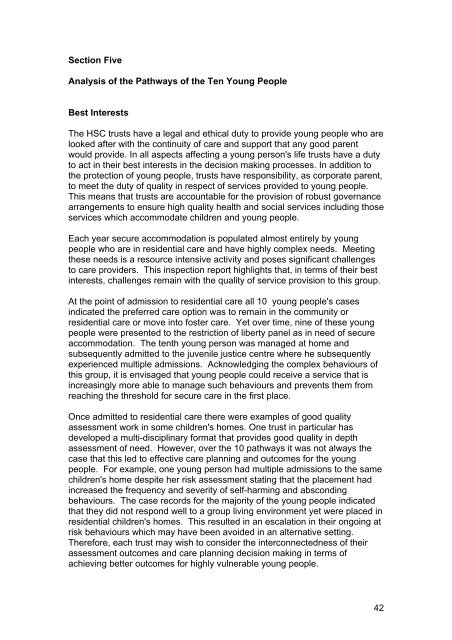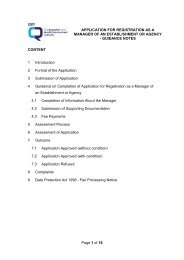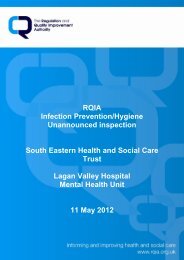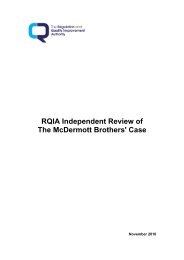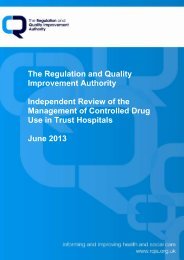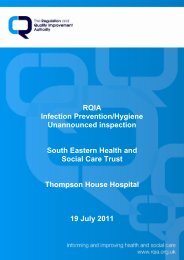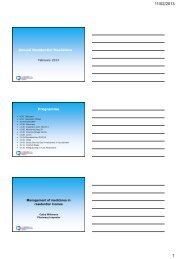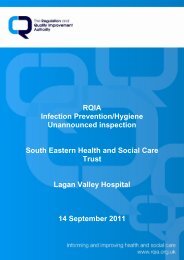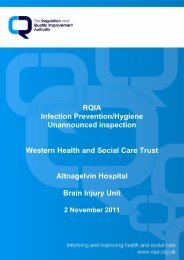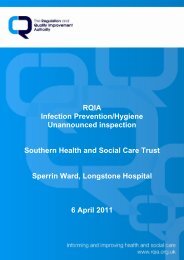A Report on the Inspection of the Care - Regulation and Quality ...
A Report on the Inspection of the Care - Regulation and Quality ...
A Report on the Inspection of the Care - Regulation and Quality ...
You also want an ePaper? Increase the reach of your titles
YUMPU automatically turns print PDFs into web optimized ePapers that Google loves.
Secti<strong>on</strong> Five<br />
Analysis <strong>of</strong> <strong>the</strong> Pathways <strong>of</strong> <strong>the</strong> Ten Young People<br />
Best Interests<br />
The HSC trusts have a legal <strong>and</strong> ethical duty to provide young people who are<br />
looked after with <strong>the</strong> c<strong>on</strong>tinuity <strong>of</strong> care <strong>and</strong> support that any good parent<br />
would provide. In all aspects affecting a young pers<strong>on</strong>'s life trusts have a duty<br />
to act in <strong>the</strong>ir best interests in <strong>the</strong> decisi<strong>on</strong> making processes. In additi<strong>on</strong> to<br />
<strong>the</strong> protecti<strong>on</strong> <strong>of</strong> young people, trusts have resp<strong>on</strong>sibility, as corporate parent,<br />
to meet <strong>the</strong> duty <strong>of</strong> quality in respect <strong>of</strong> services provided to young people.<br />
This means that trusts are accountable for <strong>the</strong> provisi<strong>on</strong> <strong>of</strong> robust governance<br />
arrangements to ensure high quality health <strong>and</strong> social services including those<br />
services which accommodate children <strong>and</strong> young people.<br />
Each year secure accommodati<strong>on</strong> is populated almost entirely by young<br />
people who are in residential care <strong>and</strong> have highly complex needs. Meeting<br />
<strong>the</strong>se needs is a resource intensive activity <strong>and</strong> poses significant challenges<br />
to care providers. This inspecti<strong>on</strong> report highlights that, in terms <strong>of</strong> <strong>the</strong>ir best<br />
interests, challenges remain with <strong>the</strong> quality <strong>of</strong> service provisi<strong>on</strong> to this group.<br />
At <strong>the</strong> point <strong>of</strong> admissi<strong>on</strong> to residential care all 10 young people's cases<br />
indicated <strong>the</strong> preferred care opti<strong>on</strong> was to remain in <strong>the</strong> community or<br />
residential care or move into foster care. Yet over time, nine <strong>of</strong> <strong>the</strong>se young<br />
people were presented to <strong>the</strong> restricti<strong>on</strong> <strong>of</strong> liberty panel as in need <strong>of</strong> secure<br />
accommodati<strong>on</strong>. The tenth young pers<strong>on</strong> was managed at home <strong>and</strong><br />
subsequently admitted to <strong>the</strong> juvenile justice centre where he subsequently<br />
experienced multiple admissi<strong>on</strong>s. Acknowledging <strong>the</strong> complex behaviours <strong>of</strong><br />
this group, it is envisaged that young people could receive a service that is<br />
increasingly more able to manage such behaviours <strong>and</strong> prevents <strong>the</strong>m from<br />
reaching <strong>the</strong> threshold for secure care in <strong>the</strong> first place.<br />
Once admitted to residential care <strong>the</strong>re were examples <strong>of</strong> good quality<br />
assessment work in some children's homes. One trust in particular has<br />
developed a multi-disciplinary format that provides good quality in depth<br />
assessment <strong>of</strong> need. However, over <strong>the</strong> 10 pathways it was not always <strong>the</strong><br />
case that this led to effective care planning <strong>and</strong> outcomes for <strong>the</strong> young<br />
people. For example, <strong>on</strong>e young pers<strong>on</strong> had multiple admissi<strong>on</strong>s to <strong>the</strong> same<br />
children's home despite her risk assessment stating that <strong>the</strong> placement had<br />
increased <strong>the</strong> frequency <strong>and</strong> severity <strong>of</strong> self-harming <strong>and</strong> absc<strong>on</strong>ding<br />
behaviours. The case records for <strong>the</strong> majority <strong>of</strong> <strong>the</strong> young people indicated<br />
that <strong>the</strong>y did not resp<strong>on</strong>d well to a group living envir<strong>on</strong>ment yet were placed in<br />
residential children's homes. This resulted in an escalati<strong>on</strong> in <strong>the</strong>ir <strong>on</strong>going at<br />
risk behaviours which may have been avoided in an alternative setting.<br />
Therefore, each trust may wish to c<strong>on</strong>sider <strong>the</strong> interc<strong>on</strong>nectedness <strong>of</strong> <strong>the</strong>ir<br />
assessment outcomes <strong>and</strong> care planning decisi<strong>on</strong> making in terms <strong>of</strong><br />
achieving better outcomes for highly vulnerable young people.<br />
42


